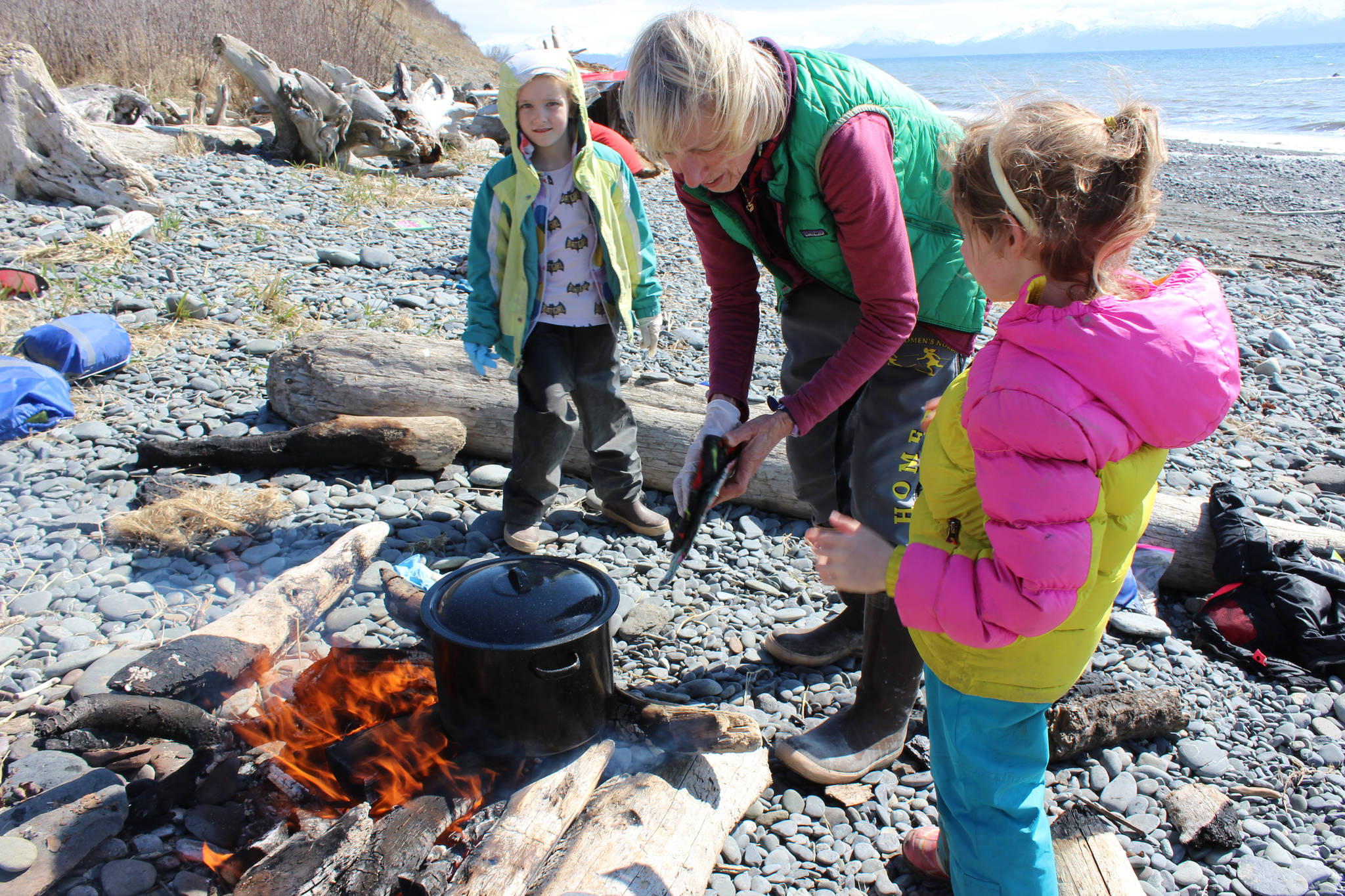Backpack-wearing, coat-dragging, loud-voiced youngsters excitedly emptied classrooms on May 2, happy the school day had ended. For 31 kindergarten through sixth-grade students from Paul Banks and West Homer Elementary schools, Fireweed Academy and Connections (the Kenai Peninsula Borough School District’s homeschool program) hours of learning still remained, but they seemed equally excited.
With adults Damara Burnett, Tania Spurkland and Derek Bynagle, the children boarded a bus and headed to the best classroom of all: one not in a school. The outing was part of KPBSD Migrant Education’s Wilderness Explorers, organized by Burnett, the migrant ed teacher for the Homer area.
Burnett began Wilderness Explorers as “a great way for me to make positive connections with kids outside the traditional classroom, adding another layer of support, while teaching safety and survival skills that are applicable to their lives.”
After arriving at the Diamond Creek trailhead, Burnett sorted the youngsters into three groups, one led by her, one by Spurkland, a former science teacher with a degree in intertidal ecology and marine algae, and one by Bynagle, a Connections advisor. The assignment: collect edible wild plants along the trail. In short order, the students found new growths of stinging nettles, horsetail fern, fireweed and twisted stalk. Specimens were carefully collected and placed in plastic bags to be combined later.
According to Tim Vlasak, the district’s Assessment, Curriculum, Federal Programs and Small Schools director, the Elementary and Secondary Education Act was enacted by the federal government in 1965 as a means to fund students not meeting national academic standards, specifically economically disadvantaged students. Over the years other student populations, including migrants, were identified and support given to address the educational needs and problems associated with students making repeated moves. Typically, KPBSD has 350-400 qualifying students at any given time.
“The Homer area has a majority of the migrant population in the district and therefore the unique position occupied by Damara,” said Vlasak. “KPBSD saw a significant increase in migrant funding in 2017-2018 due to the repositioning of states in the ranking for federal funding. I believe that Alaska now ranks sixth in identified migrant students.”
Wilderness Explorers is one part of Homer’s migrant programd and began during the 2016-2017 school year with students from Paul Banks. This school year it expanded to include West Homer, Fireweed and Connections. It meets after school, one day a week.
Wilderness Explorers students have spent a garden workday with Lori Jenkens of Synergy Farms. With help from the Alaska Department of Fish and Game, the students have gone ice fishing. With skis provided by Kachemak Nordic Ski Club, they’ve enjoyed winter outings and, with help from John Miles, constructed snow shelters. Center for Alaskan Coastal Studies led an animal-tracking event, and numerous parents have volunteered throughout the year.
“One of the big things we do, once a month, is work with Anna Borland-Ivy,” said Burnett of water safety lessons offered through collaboration with the Bay Club and AMSEA, Alaska Marine Safety Education Association. Burnett and Borland-Ivy are AMSEA-trained educators.
Most of the Wilderness Explorers students are from fishing families, said Burnett. Some of the students can swim, some can’t. Burnett and Borland-Ivy aren’t swimming instructors but do stress wearing PFDs, personal flotation devices, the entire time. Some lessons, like how to make a Mayday call and put on an immersion suit, are done out of the water. Others, like how to maneuver in an immersion suit and how to get into a raft, are done in the Bay Club pool.
“You put on an immersion suit and your world becomes so tiny. You can’t see, can’t hear. The first time the kids put them on, they were in them 10 minutes and freaked out. The last time they were in them 30 minutes and they were so comfortable,” said Borland-Ivy.
In addition to loaning immersion suits, AMSEA gave the students bandanas on which were printed the seven steps of survival: recognition, inventory, shelter, signals, water, food, play. Some of the youngsters wore the orange bandanas tied around their heads as they hiked down Diamond Creek Trail on the May 2 outing.
Once at the beach, the three groups rotated among the adults. Burnett served samples of nesto, a pesto-like spread made with nettles, and had the children make sketches of the collected plants in their journals. Spurkland had them prepare and cook over a campfire the plants they’d collected. Bynagle had them build the cooking fire and gave lessons in survival. Finally, they enjoyed sampling the fruits of their labors with a menu of salad, steamed nettles and a side of sautéed fresh vegetables provided by Spurkland.
Wilderness Explorers has one more outing before the school year ends, a camping trip to Jakolof Bay to use “all our survival skills that we’ve been working on all year,” said Burnett.
“This program has really grown under Damara’s leadership. The families that are involved have all had positive reports about the program,” said Paul Banks Principal Eric Pederson.
He encouraged families interested in the Migrant Education program or Wilderness Explorers to contact Burnett at 907-226-1888 or DBurnett@KPBS.k12.ak.us or the Migrant Education recruitment office at 907-714-8868. At the beginning of the 2018-2019 school year KPBSD will distribute via mass mailing Migrant Ed eligibility forms and Burnett encouraged they be completed and returned as soon as possible.
McKibben Jackinsky is a freelance writer. She can be reached by emailing mckibben.jackinsky@gmail.com.


